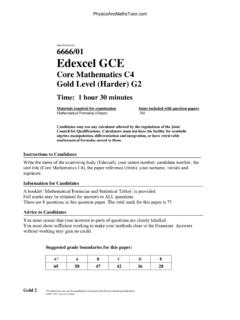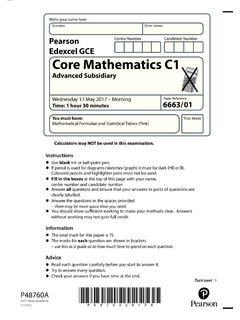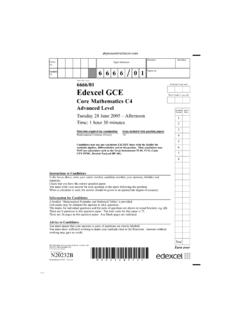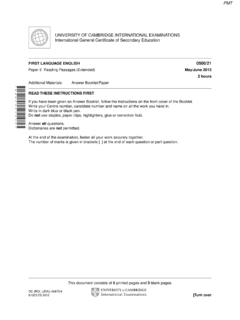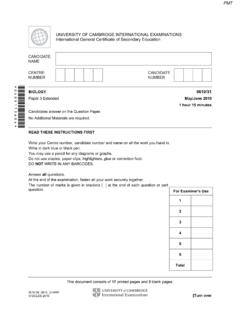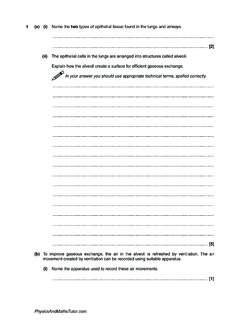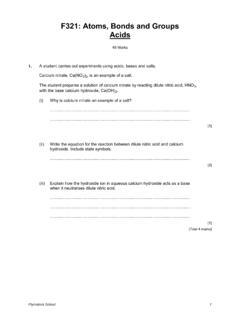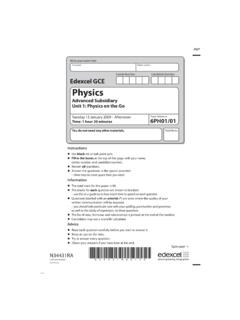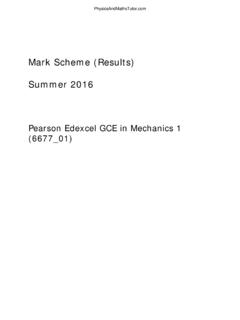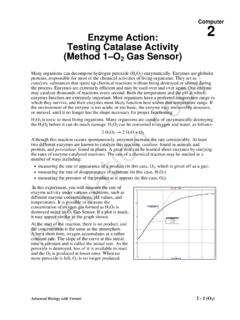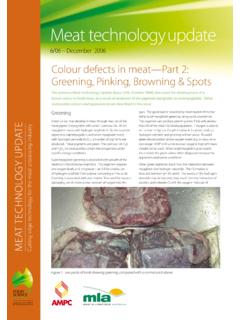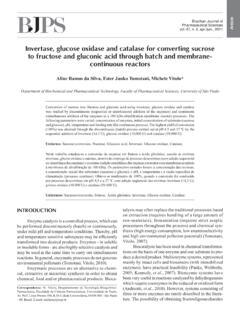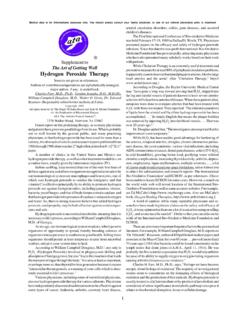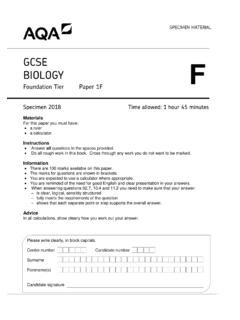Transcription of Cambridge International Examinations Cambridge ...
1 This document consists of 15 printed pages and 1 blank (NF/SG) 127826/2 UCLES 2017 [Turn overCambridge International ExaminationsCambridge International Advanced Subsidiary and Advanced Level*4506784563*BIOLOGY 9700/22 Paper 2 AS Level Structured Questions February/March 2017 1 hour 15 minutesCandidates answer on the Question Additional Materials are THESE INSTRUCTIONS FIRSTW rite your Centre number, candidate number and name on all the work you hand in dark blue or black may use an HB pencil for any diagrams or not use staples, paper clips, glue or correction NOT WRITE IN ANY all calculators may be may lose marks if you do not show your working or if you do not use appropriate the end of the examination, fasten all your work securely number of marks is given in brackets [ ] at the end of each question or part UCLES 2017 Answer all the A diagram of a chromosome from a dividing cell is shown in Fig.]
2 (a) A dividing cell is at risk of losing genetic material each time DNA replication occurs. On Fig. , add a label line and the letter G to show the location on the chromosome of an area that helps to prevent the loss of genes. [1] (b) The chromosome shown in Fig. consists of one long DNA molecule associated with histone proteins. Name one stage of mitosis in which a chromosome would have the same general structure as the chromosome shown in Fig.. [1] (c) Name the stage in the mitotic cell cycle during which the cytoplasm and the cell divide to produce two genetically identical daughter cells.
3 [1] (d) The control of the cell cycle can be affected by extracellular chemical messengers that bind to proteins and glycoproteins in the cell surface membrane. The overall mechanism is known as cell signalling. State the term used to describe the proteins and glycoproteins that function in this way.. [1][Total: 4]PMT39700/22/F/M/17 UCLES 2017[Turn over2 The infectious disease cholera is caused by a bacterium. (a) Fig. shows a transmission electron micrograph of this bacterium. 30 000 Fig. (i) Name the bacterium that causes cholera.. [1] (ii) The bacterium in Fig. is an example of a prokaryotic cell.]
4 Each of the descriptions A to C describes a cell structure found in prokaryotic cells and in plant cells. For each of the descriptions A to C: name the cell structure described state one difference in this structure between a prokaryotic cell and a plant cell. A the site of polypeptide synthesiscell structure ..difference .. B the genetic material of the cellcell structure ..difference .. C the structure that provides a rigid shape to the cell and prevents osmotic lysiscell structure ..difference ..[6]PMT49700/22/F/M/17 UCLES 2017 (b) Cholera is an example of an infectious disease.
5 Explain what is meant by an infectious disease.. [2] The symptoms of cholera are caused by choleragen, a toxin released by the bacterium. Choleragen is a protein made up of six polypeptides: a single copy of a polypeptide known as the A subunit that includes an extended alpha helix five polypeptides that together make the B subunit. The B subunit of choleragen binds to a cell surface membrane component, known as GM1, of an intestinal epithelial cell. The complete choleragen protein then enters the cell by endocytosis. Once inside the cell, the A subunit of the protein acts as an enzyme, disrupting the normal functioning of the cell. (c) List the levels of protein structure present in choleragen.
6 [2] (d) Outline the mechanism by which choleragen enters the cell. You may use the space for annotated diagrams.. [3]PMT59700/22/F/M/17 UCLES 2017[Turn over (e) Using genetic engineering, it is possible to produce a form of choleragen consisting of only subunit B. This can be combined with inactivated bacterial cells to produce a vaccine against cholera. (i) Suggest why subunit B, rather than subunit A, is used in the vaccine.. [1] (ii) Outline how this vaccine can give protection against cholera.. [5][Total: 20]PMT69700/22/F/M/17 UCLES 20173 catalase is an enzyme that catalyses the breakdown of hydrogen peroxide , a toxic waste product of metabolism.]
7 Catalase2H2O2 2H2O + O2 Fig. shows the results of an investigation into the effect of hydrogen peroxide concentration on the rate of the catalase -controlled reaction, with and without the presence of two different peroxide concentration / mmol dm 3rate of reaction/ arbitrary unitsXYZFig. (a) The inhibitors used in the investigation have different modes of action. Identify which of curves X, Y and Z are the results for: the reaction with the non-competitive inhibitor the reaction with the competitive inhibitor the reaction without any inhibitor. non-competitive inhibitor .. competitive inhibitor.
8 Without any inhibitor ..[1]PMT79700/22/F/M/17 UCLES 2017[Turn over (b) With reference to Fig. , compare the maximum rate of reaction, Vmax, and the Michaelis-Menten constant, Km, for curves X, Y and ..Km ..[4] hydrogen peroxide has a harmful effect on cells. One effect is to damage DNA. (c) Describe the structure of DNA.. [4]PMT89700/22/F/M/17 UCLES 2017 (d) The cell has mechanisms to repair the damage to DNA caused by hydrogen peroxide . Errors in repair may cause a change to the structure of DNA. Studies have investigated possible risks associated with foods and drinks that contain hydrogen peroxide .]
9 This is because the compound can be considered a mutagen. Mutagens cause mutations. Explain why hydrogen peroxide can be considered a mutagen.. [2][Total: 11]PMT99700/22/F/M/17 UCLES 2017[Turn overQuestion 4 starts on page 10 PMT109700/22/F/M/17 UCLES 20174 The transport systems of plants and mammals both function to transport substances to and from cells. (a) Table contains descriptions concerning the mammalian circulatory system and the structure of the heart. Complete Table by writing down the term that matches each transport system where blood is enclosed in blood vessels and passes through the heart twice in one complete circuit of the bodyblood vessel, with a lumen of approximately 7 m in diameter, that supplies substances to cellsthe blood vessel that carries oxygenated blood from the lungs to the heartthe chamber of the heart that receives deoxygenated blood from the bodythe structure dividing the heart into the left and right sides[5] (b) Water is the main component of the fluids associated with transport in mammals and plants.]
10 (i) One property of water is its ability to act as a solvent. Suggest why this property is important in the mammalian transport system.. [2]PMT119700/22/F/M/17 UCLES 2017[Turn over (ii) The transport of water in plants depends on the ability of water molecules to form hydrogen bonds. Explain how hydrogen bonding is involved with the movement of water in the xylem.. [3][Total: 10]PMT129700/22/F/M/17 UCLES 20175 (a) Smooth muscle and cartilage are two of the tissues found in the walls of structures of the gas exchange system of mammals. Complete Fig.]
